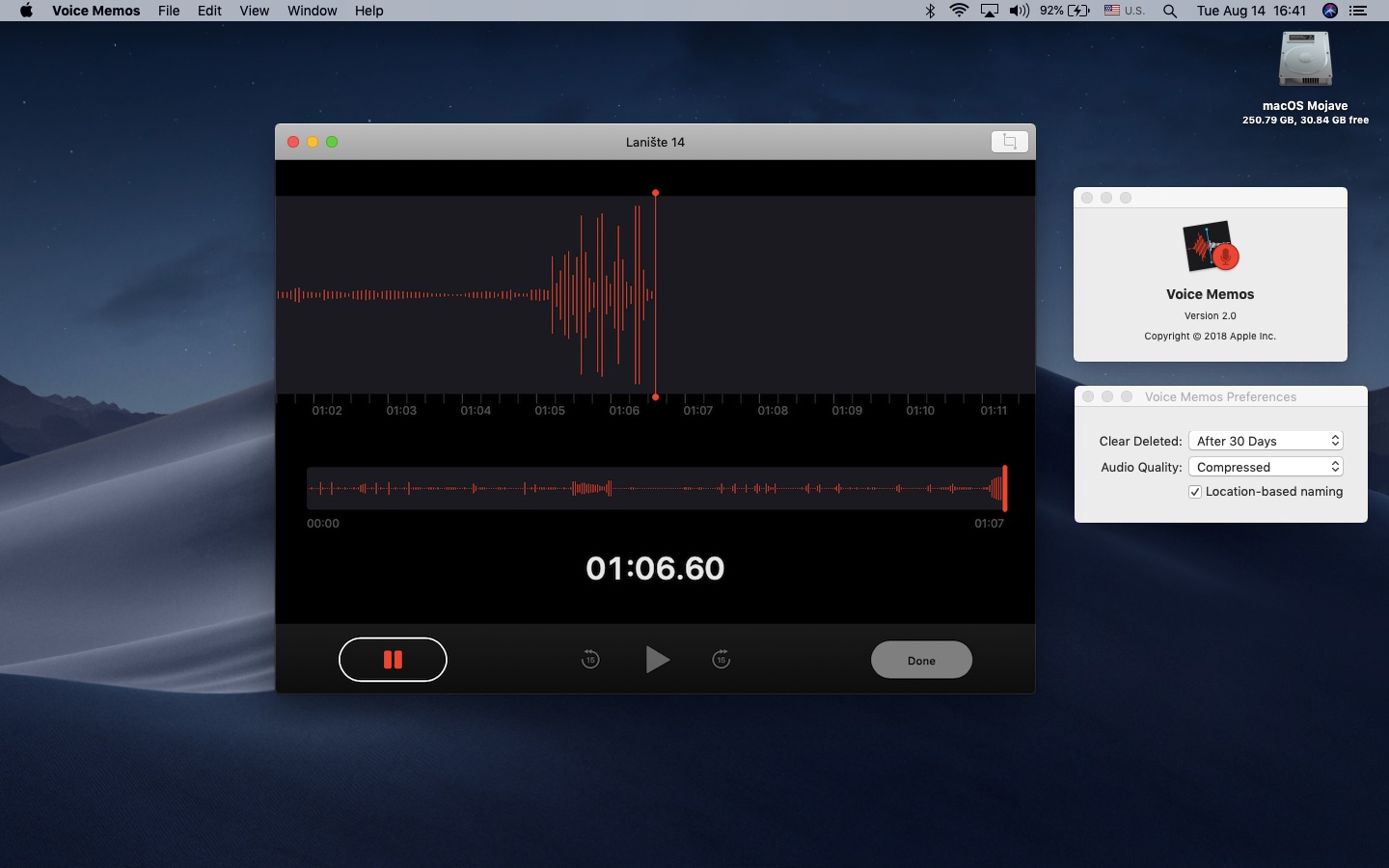Voice Memo For Mac Download
Move Voice Memos from iPhone to Mac Via Email. Transferring iPhone voices memos to Mac with.
Voice Memo For Mac Download Torrent
Voice Memos is a new addition from iOS to macOS Mojave; it’s a simple one-trick-pony of an app that lets you record, play back, and share short audio recordings.
Consider all the times you’d find it useful to have an audio recorder in your MacBook — perhaps when you’re attending a lecture or interviewing an important source (a big deal for writers). Or maybe you just want to record a quick reminder (“Pick up milk after work”). Well, you’re in luck. Mojave now includes the same built-in digital voice recorder you know and love on your iPhone (and other iDevices).
How to record a voice memo
Launch Voice Memos, and you’ll see the simple window displayed here.
Recordings use your Mac’s built-in microphone by default. If you prefer to use a different microphone, select it in the Sound System Preferences pane’s Input tab before you begin recording.
Click the big red button to start a recording. The waveform that moves across the screen as Voice Memo detects sounds helps you gauge the recording level.
You can pause a recording by clicking the red pause button, and then click it again to resume recording.
A timer on the screen indicates the length of your recording session (24.36 in the figure).
Click Done when you’re finished to save the recording. It’s that easy.
Download adobe flash free chrome. To adjust the recording level, visit the Sound System Preferences pane’s Input tab and adjust the Input Volume slider.
How to listen to a voice memo
After you capture your thoughts or musings, you’ll probably want to play them back. To do so, just click the voice memo you want to hear (Second Recording in the figure), and then click the triangular Play button to listen.
This evolution from single-frame images to computer graphics has been assisted by 3D animation software, which allows users to customise each individual frame of the animation and add visual effects for spin, rotation, fade and transparency. Taking images and turning them into 3D models, figures will morph from virtual skeletons into lifelike characters. Animation software takes concepts and gives them life in a variety of amazing ways. 
You can drag the playhead (the vertical blue line in the middle of the waveform) to move forward or back in the memo.
How to name a voice memo
When a memo is added to your list of recordings, it shows up with the date and length of the recording and the uninspiring title New Recording. You could have named it something else at that point, but if you didn’t, you may have a tough time remembering which recording was made for which purpose. Fortunately, you can easily create a custom title after the fact:
- Click any Voice Memo in the sidebar.
- Click the name Apple assigned (New Recording 1, New Recording 2, and so on).
- Type your own name for the voice memo.
Professor Snookins on Biology, for example.
That’s it. Your recording is duly identified.
How to trim a voice memo
Maybe the professor you were recording rambled on and on. Fortunately, it’s easy to trim the audio. To do so, first click a recording and then click the Edit button in the upper-left corner of the window.
Now, click the trim icon (labeled in the figure) and drag the start and end markers to determine the portion of the audio you want to keep.
To conclude the process, click the trim icon — but before you do, I recommend that you preview your edit by clicking the Play button. If you’re happy, click the trim icon.
If you make a mistake, choose Edit → Undo immediately to restore the audio you trimmed.
You may want to share a Voice Memo with others. No problem. Just click a Voice Memo to select it, and then click the share icon. You then have the option to email the memo or send it in a message. Or you can share it instantly with Mac or iDevice users via AirDrop, or add it to the Notes app.
Here’s another cool trick you can do with a recording. Email the recording to yourself, download it onto your Mac, change its extension to .m4r, and then add the recording to iTunes. Presto, you’ve added a ringtone.
When you have no further use for a recording, you can remove it from the Voice Memos app by selecting it and pressing Delete (or Backspace).
Almost all iPhone users use Voice Memos application on iPhone for different reasons. You can record a conversation, a live show, and the notes that you are preparing for your thesis, lecture, work and so on. If you are trying to get these memos out of your iPhone, you do have certain options such as through iTunes or iCloud. However, the process changes according to different situations. Sometimes it is really time-consuming.
In this article, we are going to present you three different methods through which you can quickly download the voice memos from your iPhone with just several steps.
1 Download voice memos from iPhone Using iTunes

Just follow these steps below to use iTunes to download the voice memos from your phone to computer.
Step 1: Ensure that you have the latest iTunes version. If not, head to the settings and update to the latest version.
Step 2: You can connect your iPhone through Wi-Fi sync or with the given USB cable to the computer.
Step 3: Based on your settings, iTunes will pop-up automatically once it detects the device. If not, launch the application manually. From the main interface, tap the phone icon, which represents your iPhone.
Step 4: Under the 'Summary' tab, tap the 'Music' option.
Step 5: Under the sync option, check the 'voice memos' option.
Step 6: Press the 'Apply' button to allow iTunes to synchronize the voice memos files present on your iPhone.
The process will begin syncing the voice memos to your computer and save in the iTunes Library. You can then find the files in iTunes library folder and save them anywhere else you want on your computer.
2 Selectively Download iPhone Voice Memos Via 3rd-Party Tool
iMyFone D-Port iPhone Data Exporter, unlike other data transfer tools, is a proficient iPhone data exporter and helps you in extracting data from your iPhone. See what the program can do for you.
iMyFone D-Port iPhone Data Exporter
Key Features:
- Exports voice memos, videos, notes and more from iPhone, iPad, and iPod touch.
- View and extract your data in old iTunes or iCloud backups.
- Fully back up or selectively back up Messages, WhatsApp messages and WeChat data.
- Released by iMyFone company, which is trusted by millions of customers.
- 30-day money back guarantee and free trial version are offered.

Steps to Download Voice Memos via iMyFone D-Port
Step 1: Download and install the software by visiting the iMyFone official download center. Launch the program and from the main window, choose 'Back Up & Export from Device'. Press the 'Export Data' button.
Step 2: In the next screen, you have to select 'Voice Memo' as the file type that you wish to export from your iPhone. Press 'Next' button to continue, where you have to establish a connection between the computer and your phone.
Step 3: Once the application detects the phone, it will scan and display the informations on iPhone. You can preview the files, and select only those you need. Once done, press the 'Export' button.
Step 4: In the next pop-up window, mention the location where you want to save the files. Wait until the program completes the process and then you are done.
It is easy to operate, right? And just download the free trial of iMyFone D-Port iPhone Data Exporter and have a try now!
3 Download iPhone Voice Memos via Email/Dropbox/MMS
Other ways to download voice memo files to your computer from iPhone is by using Dropbox, Email, and MMS services. You can attach the voice memo file to your email and download the same on your computer. Let us look at the steps involved in downloading the files using Dropbox.
Step 1: Open the voice memo app. Select the file that you need.
Step 2: Select the 'Share' button to open a small menu, where you can choose Message/Mail/Dropbox and more.
Step 3: Choose message or mail to send the voice memo to the person you want to share with. Or you can choose upload to Dropbox by saving in the opened destination location or creating a new folder after selecting 'Choose a Different Folder' option.
Step 4: You can now open Dropbox application on your computer, and copy the saved voice memo to your computer.